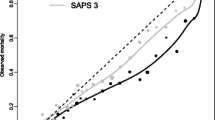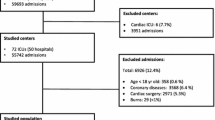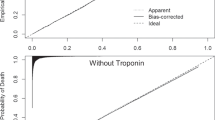Abstract
Objective
To test the prognostic performance of the SAPS 3 Admission Score in a regional cohort and to empirically test the need and feasibility of regional customization.
Design
Prospective multicenter cohort study.
Patients and setting
Data on a total of 2,060 patients consecutively admitted to 22 intensive care units in Austria from October 2, 2006 to February 28, 2007.
Measurements and results
The database includes basic variables, SAPS 3, length-of-stay and outcome data. The original SAPS 3 Admission Score overestimated hospital mortality in Austrian intensive care patients through all strata of the severity-of-illness. This was true for both available equations, the General and the Central and Western Europe equation. For this reason a customized country-specific model was developed, using cross-validation techniques. This model showed excellent calibration and discrimination in the whole cohort (Hosmer–Lemeshow goodness-of-fit: Ĥ = 4.50, P = 0.922; Ĉ = 5.61, P = 0.847, aROC, 0.82) as well as in the various tested subgroups.
Conclusions
The SAPS 3 Admission Score’s general equation can be seen as a framework for addressing the problem of outcome prediction in the general population of adult ICU patients. For benchmarking purposes, region-specific or country-specific equations seem to be necessary in order to compare ICUs on a similar level.

Similar content being viewed by others
References
Moreno RP, Metnitz PhGH (2007) Severity of illness scoring systems. Tools for the evaluation of patients and ICUs. In: Parrillo JE, Dellinger RP (eds) Critical care medicine: principles of diagnosis and management in the adult, 3rd edn. Elsevier, Amsterdam
Moreno R, Morais P (1997) Outcome prediction in intensive care: results of a prospective, multicentre, Portuguese study. Intensive Care Med 23:177–186
Metnitz PG, Valentin A, Vesely H, Alberti C, Lang T, Lenz K, Steltzer H, Hiesmayr M (1999) Prognostic performance and customization of the SAPS II: results of a multicenter Austrian study. Intensive Care Med 25:192–197
Metnitz PhGH, Moreno RP, Almeida E, Jordan B, Bauer P, Abizanda-Campos R, Iapichino G, Edbrooke D, Capuzzo M, Le Gall JR, on behalf of the SAPS 3 investigators (2005) SAPS 3—from evaluation of the patient to evaluation of the intensive care unit. Part 1: Objectives, methods and cohort description. Intensive Care Med 31:1336–1344
Moreno RP, Metnitz PhGH, Almeida E, Jordan B, Bauer P, Abizanda-Campos R, Iapichino G, Edbrooke D, Capuzzo M, Le Gall JR, on behalf of the SAPS 3 Investigators (2005) SAPS 3—From evaluation of the patient to evaluation of the intensive care unit. Part 2: Development of a prognostic model for hospital mortality at ICU admission. Intensive Care Med 31:1345–1355
Metnitz B, Metnitz PhGH, Bauer P, Valentin A on behalf of the ASDI Study Group (2008) Patient volume affects outcome in critically Ill patients. Wien Klin Wochenschr 120 (in press)
For further information see also http://www.asdi.ac.at
Metnitz PhGH, Steltzer H, Popow C, Valentin A, Lenz K, Neumark J, Sagmüller G, Schwameis F, Urschitz M, Hiesmayr M (1997) Definition and evaluation of a documentation standard for intensive care medicine: the ASDI pilot project. Wien Klin Wochenschr 109:132–138
Miranda DR, De Rijk A, Schaufeli W (1996) Simplified therapeutic interventions scoring system: the TISS-28 items—results from a multicenter study. Crit Care Med 24:64–73
Hosmer DW, Lemeshow S (1995) Confidence interval estimates of an index of quality performance based on logistic regression models. Stat Med 14:2161–2172
Lemeshow S, Hosmer DW (1982) A review of goodness-of-fit statistics for use in the development of logistic regression models. Am J Epidemiol 115:92–106
Hanley JA, McNeil BJ (1981) The meaning and use of the area under a receiver operating characteristic (ROC) curve. Radiology 143:29–36
Moreno R, Apolone G (1997) The impact of different customization strategies in the performance of a general severity score. Crit Care Med 25:2001–2008
Table E10 of the ESM of the SAPS 3 admission score main report, to download from: http://www.springerlink.com/content/t78746238246416j/
Miranda DR, Ryan DW, Schaufeli WB, Fidler V (1998) Organization and management of intensive care. In: Vincent JL (ed) Update in intensive care medicine, vol 29. Springer, Berlin
Metnitz PhGH, Kopp A, Jordan B, Lang Th (2004) More interventions do not necessarily improve outcome in critically ill patients. Intensive Care Med 30:1586–1593
Azoulay E, Jordan B, Sprung C, Timsit JF, Lemaire F, Schlemmer B, Moreno R, Metnitz P (2007) End-of-life practices in intensive care units: worldwide data from the SAPS 3 database. Intensive Care Med 33(Suppl 1):A779
Vincent JL (1999) Forgoing life support in western European intensive care units: the results of an ethical questionnaire. Crit Care Med 27:1626–1633
Yende S, Kammerer CM, Angus DC (2006) Genetics and proteomics: deciphering gene association studies in critical illness. Crit Care 10:227
Kellum JA, Angus DC (2003) Genetic variation and risk of sepsis. Minerva Anestesiol 69:245–253
Soares M, Salluh JI (2006) Validation of the SAPS 3 admission prognostic model in patients with cancer in need of intensive care. Intensive Care Med 32:1839–1844
Ledoux, Canivet JL, Preiser JC, Lefrancq J, Damas P (2008) SAPS 3 admission score: an external validation in a general intensive care population. Intensive Care Med 34 (in press)
Zhu B-P, Lemeshow S, Hosmer DW, Klarm J, Avrunin J, Teres D (1996) Factors affecting the performance of the models in the mortality probability model and strategies of customization: a simulation study. Crit Care Med 24:57–63
Metnitz PhGH, Vesely H, Valentin A, Lang T, Le Gall JR (2000) Ratios of observed to expected mortality are affected by differences in case mix and quality of care. Intensive Care Med 26:1466–1472
Acknowledgments
We thank the members of the ASDI study group and their respective study co-ordinators in each ICU: Günter Sagmüller, UKH Meidling, Vienna; Franz Schwameis, Landesklinikum Thermenregion Baden, Baden; Brigitte Pichler, Landesklinikum Weinviertel Mistelbach/Gänserndorf, Mistelbach; Felix Ernst, Landesklinikum Weinviertel Mistelbach/Gänserndorf, Mistelbach; Thomas Bauer, Landesklinikum Krems, Krems A. D. Donau; Franz Sterrer, A. ö. LKH Vöcklabruck, Vöcklabruck; Helmut Trimmel, A. ö. KH Wiener Neustadt, Wiener Neustadt; Walter Klimscha, Donauspital SMZ Ost, Vienna; Dieter Linemayr, Landesklinikum Mödling, Mödling; Johannes Schuh, A. ö. KH Wiener Neustadt, Wiener Neustadt; Gabriele Sprinzl, Landesklinikum Donauregion Tulln, Tulln; Kurt Dörre, A. ö. KH Waidhofen a.d. Thaya, Waidhofen A. D. Thaya; Helmut Trimmel, A. ö. KH Wiener Neustadt, Wiener Neustadt; Günther Frank, A. ö. KH der Barmherzigen Brüder Eisenstadt, Eisenstadt; Heinz Malle, UKH Klagenfurt, Klagenfurt; Ingrid Schindler, Sozialmedizinisches Zentrum Floridsdorf, Vienna; Sylvia Fitzal, Wilhelminenspital der Stadt Wien, Vienna; Reinhard Schuster, Donauspital SMZ Ost, Vienna; Gottfried Locker, AKH Wien Universitätskliniken, Vienna; Helmut Schneller, A. ö. KH der Barmherzigen Brüder Linz, Linz; Hubert Artmann, Kardinal Schwarzenberg’sches Krankenhaus, Schwarzach/Pongau; Oswald Schuberth, A. ö. LKH Steyr, Steyr; Statistical analysis was supported by a grant from the Fund of the Austrian National Bank, Project # 12690 ONB.
Conflict of interest statement
The authors declare that there exist no financial or other conflicts of interest. None of the authors has recently been employed or received reimbursements, fees, funding, or salary by/from an organization that may in any way gain or lose financially from the publication of this manuscript. No author holds any stocks or shares or patents in/from an organization that may in any way gain or lose financially from the publication of this manuscript.
Author information
Authors and Affiliations
Consortia
Corresponding author
Electronic supplementary material
Below is the link to the electronic supplementary material.
Rights and permissions
About this article
Cite this article
Metnitz, B., Schaden, E., Moreno, R. et al. Austrian validation and customization of the SAPS 3 Admission Score. Intensive Care Med 35, 616–622 (2009). https://doi.org/10.1007/s00134-008-1286-2
Received:
Accepted:
Published:
Issue Date:
DOI: https://doi.org/10.1007/s00134-008-1286-2




